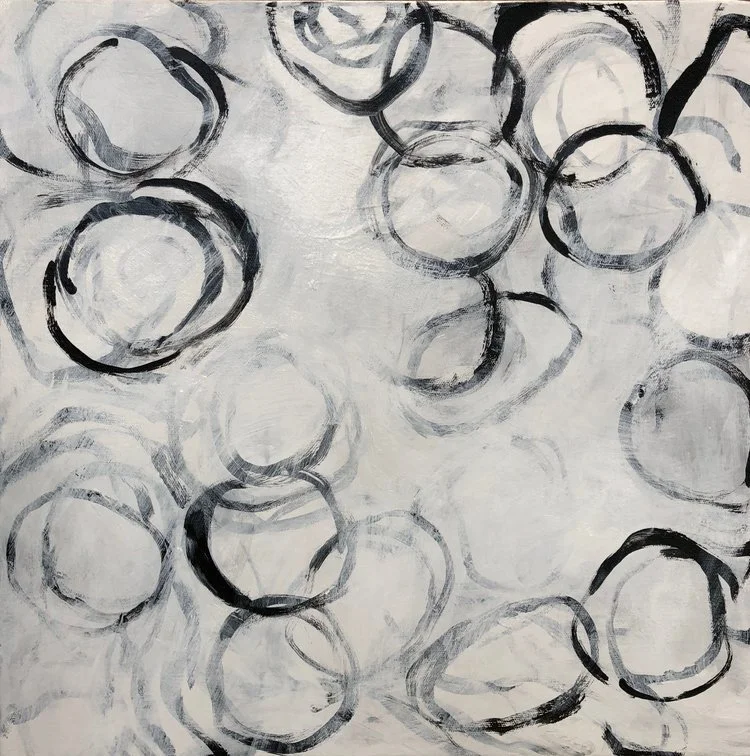LINE & MARK
“LINE: The recorded movement of a dot on its journey from one place to another.”
The most basic element of art, a line was used by the earliest man/woman right up to the last word you wrote or doodled. Classically speaking, “Line” is the first fundamental element of design, however for art, and abstraction in particular, I am including “Mark” as well. A line can be BIG AND BOLD or light and airy. Squiggly or smooth, straight or curvilinear. A line has length by definition; it is “a long narrow mark.” How long or narrow is, of course, relative. In art, lines typically relate to each other somehow by intersecting, running parallel or touching. Much can be done with lines as we will see.
All Lines are Marks, but not all Marks are Lines.
“MARK: An impression, deposit or remnant left on a surface as the result of contact by a tool or object.”
Marks are infinite in description from dots to handprints, from smears to drips. In art, however, a mark represents the “hand of the maker” (as Mr. Aimone aptly points out), and therefore it embodies a recording of your process and essentially of YOU! Marks (and lines) can express meaning, emotion, movement, depth and more. Let’s look at a few ways to explore line in the video below.
Steven Aimone is the author of an excellent book titled, “Expressive Drawing - A Practical Guide to Freeing the Artist Within.” Unfortunately it is out of print, but if you can find one for a decent price, grab it. Search on Google and there are used copies available. He also teaches interesting workshops.
Exploring Line
Please Note: Each video in this course has its own unique password.
VIDEO PASSWORD: Charcoal
VIDEO LENGTH: 10:31 minutes
PROJECT IDEAS
MORE PROJECT IDEAS:
Diagonal Lines: Fill a page with only diagonal lines that move your eye around the page.
Emotional Lines: Fill a page with Lines expressing one emotion such as Love, Anger, Joy, or Sadness.
Musical Lines: Create a drawing of Lines and Marks while listening to your favorite song.
Talking Lines: Make a Mark with your dominant hand and then respond with a Mark from your non-dominant hand. Continue back and forth until you feel the drawing is complete.
Staccato: Fill a page with short lines and marks.
Eyes Closed: Make a drawing with your eyes closed…or at least start one that way.
Erase: Fill a page with soft charcoal and erase all of your lines.
Line and Layering
Please Note: Each video in this course has its own unique password.
VIDEO PASSWORD: Layers
VIDEO LENGTH: 21:04 minutes
Artist Focus
〰️
JERI LEDBETTER
〰️
Artist Focus 〰️ JERI LEDBETTER 〰️
Click on any image to see larger
Jeri Ledbetter uses an assortment of mixed media to create sublime and subtle works that focus mainly on line. Her work is a perfect example of the amazing versatility of line, and how expressive this ‘simple’ element can be. Here is her artist’s statement:
“Living on the Mississippi River, I find nature’s oddities compelling and inspiring. I see man-made structures, a fence, a barge, the cobble stones, all striving for survival with water, wind and vines. And time.
The contrast of, and interplay between, industry and nature are of great interest to me as an artist. When working, I cast about for the accidental, for surprises and often my labor is a scouring from low to high or from the bottom up, I find.
Rather than paint a realistic landscape or figure, for example, I let paint and pencil, instruments cast from natural objects by industry, paint the surface, much like wind and water toil against the works of man, i.e., by slow erosion, accretion and erasure.
I let the involuntary or free hand not be unduly controlled by my plan or scheme, allowing for the blessing of the unexpected line or stroke. In sum, what I do is like digging for clams on the seashore. When it works and I hear the rattle of the shells in my bucket, I smile.”
Jeri Ledbetter talks about her work
INTERPLAY New Paintings by Jeri Ledbetter and Rebecca Crowell
CONCLUSION
LINE
Now you have seen how LINE alone can be a pretty amazing source of inspiration. There are infinite ways to incorporate just this single element into your work! You might even consider spending a week or a month (or longer) on just this one concept. But let’s move on to the next element, VALUE, as it will bring even more clarity into your work.





















